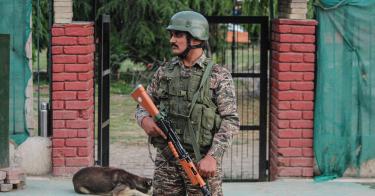When terrorists opened fire on a bus carrying tourists in Pahalgam, Kashmir, last week, they were aiming for more than innocent lives. They sought to reignite old fires, destabilize India from within, and fracture Kashmir’s calm.
The attack is a stark reminder that terrorism remains a live threat in the region. And while India is more than capable of leading its own response to this threat, Washington has a role to play—not by intervening, but by standing beside its partner.
Kashmir’s Recent Calm
In August 2019, the Indian parliament voted overwhelmingly to abrogate Article 370 of the Indian constitution and recognized Jammu and Kashmir as a Union Territory. Since then, contrary to widespread predictions of increased unrest, the region has experienced a marked decline in violence. According to the Ministry of Home Affairs, terrorist-initiated incidents dropped from 228 in 2018 to 43 in 2023, with civilian fatalities decreasing from 55 to 13 in the same period.
The improved security environment led to a growing tourism boom. Visitor numbers surged from approximately 3.47 million in 2020 to a record 23.6 million in 2024, marking a 580% increase over four years. The 2025 season began strong, with more than 814,000 visitors to Srinagar’s Tulip Garden in just 26 days. These numbers highlight what sustained stability can achieve—and why it must not be taken for granted.
A Swift U.S. Response
That stability was briefly shattered when terrorists stormed a peaceful valley on April 22, slaughtering tourists for the crime of being Hindu. Recognizing the seriousness of the Pahalgam attack, which occurred while Vice President JD Vance was visiting India, the United States responded swiftly. President Donald J. Trump condemned the incident, stating: “Deeply disturbing news out of Kashmir. The United States stands strong with India against terrorism. Prime Minister Modi and the incredible people of India have our full support.”
>>> Why U.S. Tariffs Can Be an Unlikely Opportunity for India
U.S. Director of National Intelligence Tulsi Gabbard also expressed strong solidarity. “We stand in solidarity with India in the wake of the horrific Islamist terrorist attack targeting and killing 26 Hindus in Pahalgam,” she said. “My prayers and deepest sympathies are with those who lost loved ones, Prime Minister Modi, and all the people of India. We are with you and support you as you hunt down those responsible for this heinous attack.” Multiple U.S. lawmakers across party lines also issued statements condemning the attack and affirming support for India.
The U.S. response is not just about standing with a partner in a moment of grief; it reflects a broader strategic reality. A secure Kashmir strengthens India’s ability to play a leading role in promoting stability and prosperity across the Indo-Pacific. With internal security consolidated, India has sought to move beyond historical disputes with Pakistan and focused on building strategic partnerships to address larger regional and global challenges, particularly balancing China’s growing influence.
A stable Kashmir allows India to concentrate its efforts outward on advancing economic growth, enhancing regional connectivity, and contributing to a free, open, and resilient Indo-Pacific. Supporting India’s internal stability thus directly advances shared U.S.-India objectives for regional order and prosperity.
Time for a Counterterrorism 2.0 Reset
As both nations look ahead, the Pahalgam attack serves as a reminder that old threats still linger—and that India-U.S. counterterrorism cooperation must be renewed and modernized. Counterterrorism was once a cornerstone of U.S.-India relations, especially following the 2008 Mumbai attacks. However, as the partnership expanded into new domains—trade, technology, and defense cooperation—counterterrorism gradually receded into the background.
The recent extradition of Tahawwur Rana to India, and the strong counterterrorism language in the recent U.S.-India joint statement issued during Indian Prime Minister Narendra Modi’s visit to Washington in February, reflect the enduring relevance of this pillar. Washington and New Delhi must update their collaboration to meet today’s challenges, including cyber-radicalization, narco-terror financial flows, and advanced terror financing networks.
Strengthening U.S.-India Cooperation: How Washington Can Support India
While direct U.S. intervention in Kashmir is neither needed nor appropriate, the two sides can look to strengthen cooperation in related areas.
Internal Security Cooperation:
The U.S. can enhance India’s internal security capacity by expanding intelligence sharing, with a greater focus on predictive analytics such as radicalization pattern mapping and early threat detection. Revitalizing the U.S.-India Counterterrorism and Law Enforcement Dialogue and institutionalizing regular Homeland Security Dialogue meetings—both recently restarted—would help sustain momentum and modernize bilateral counterterrorism collaboration.
>>> Venezuela’s Aggression Toward Guyana Must End
External Security and Surveillance Collaboration:
The U.S. can assist India in strengthening border security and surveillance capabilities by facilitating access to smart technologies, including Intelligence, Surveillance, and Reconnaissance drones, advanced sensors, and detection systems. Space-based surveillance collaboration, such as sharing satellite imagery for activity monitoring along the Line of Control and the border, can further bolster India’s defenses.
Soft Power and Public Diplomacy Initiatives:
Beyond hard security, the U.S. can reinforce Kashmir’s stability by promoting soft-power initiatives. Celebrating Kashmir’s tourism revival, expanding cultural and educational exchanges, and highlighting stories of progress can help strengthen narratives of peace and normalization.
The horrific terrorist attack in Pahalgam is not merely India’s burden to bear. It is a reminder that while great strides have been made toward peace and stability, old threats can all too easily resurface. The U.S. can continue to support India’s emergence as a pillar of regional and global leadership—not through intervention, but through deeper cooperation, vigilance, and support.
Strengthening India’s internal resilience today will help secure the Indo-Pacific tomorrow. Friends do not stand silent—they stand together, especially when it matters most.
This piece originally appeared in 1945



